By Matt Pedersen
Excerpt from AMAZONAS Magazine
July/August 2018
Consider this case: “When I was working in tropical fish retail, we had a customer who was hyperallergic to bloodworms. He usually called ahead to make sure we were not feeding frozen bloodworms for the two or three days prior, because if we did, just walking into the store made him instantly unwell. Keep in mind that the entrance was 25–30 yards away from the fish section. Direct bloodworm exposure would send him to the hospital right away, as we found out the hard way.
“One day, before we knew of his sensitivity, we had fed bloodworms and I bagged fish for him, of course holding the bag with wet hands. A few drops of contaminated water on the outside seeped through the newspaper we wrapped the bag in and when he touched it, he literally fell over backwards. Luckily, he had an EpiPen in his bag. An ambulance rushed him to the hospital. This type of reaction isn’t common, but rashes are quite frequent and bloodworm dust is definitely the worst.”
—Reported by Stephan Tanner, Ph.D.
Senior Editor, AMAZONAS Magazine
Whether you have a touch of itchy hands or (rarely) a reaction so severe you’re heading to the ER, bloodworm allergy is a real health concern for some aquarists. A popular, richly nutritious, and extremely effective fish food that is usually sold in frozen or freeze dried versions, these bright red chironomid midge larvae are very attractive to finicky fishes. They are a classic and effective conditioning food and have long been used by aquarium fish breeders to get their broodstock primed for spawning.
Bloodworms get their common name from their bright red coloration, a result of the hemoglobins in their bodies. These hemoglobins are powerful oxygen scavengers that allow the larval chironomids to survive in organic-rich, oxygen-deprived bodies of water. The same hemoglobins are responsible for the allergic reactions that some people have to coming in contact with bloodworms.
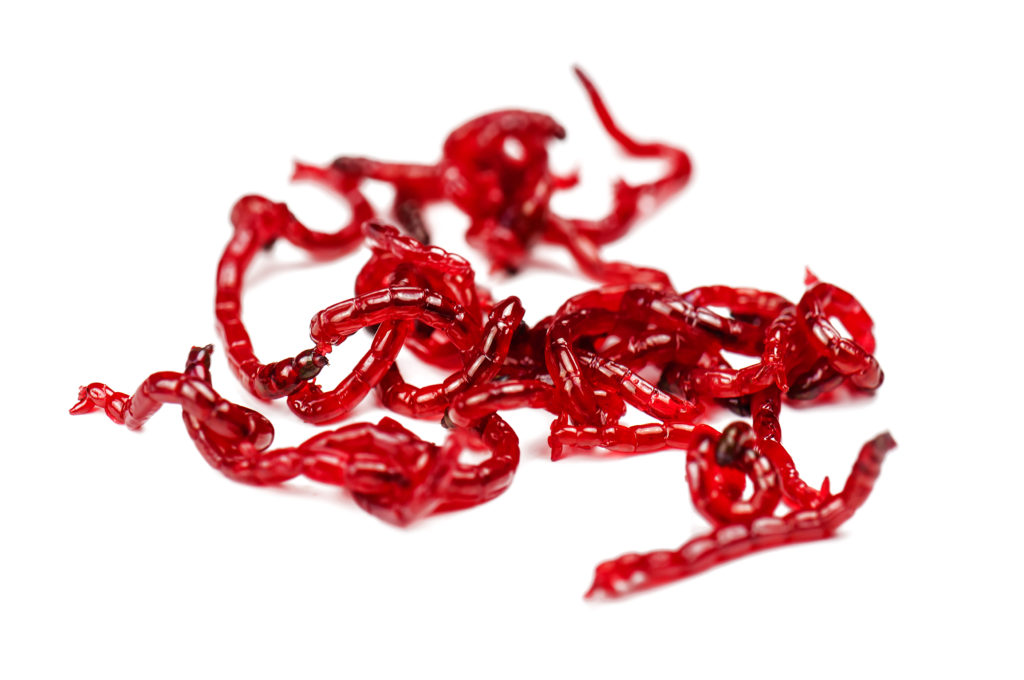
Pigmented by rich hemoglobins, these live bloodworms are a classic fish food used by serious aquarists to feed broodstock and finicky fishes.
Researchers have understood for a long time that bloodworm allergies are found mainly among aquarists. From a 2005 report, Fishing for Allergens: Bloodworm-Induced Asthma: “Although chironomids can be found in Europe, North America, and parts of Asia, allergies to them are mainly due to their use as fish food. Individuals at particular risk of chironomid-induced allergy include fish farmers, fishermen, pet shop owners, and others who keep fish or work with fish” (Wu et al. 2005).
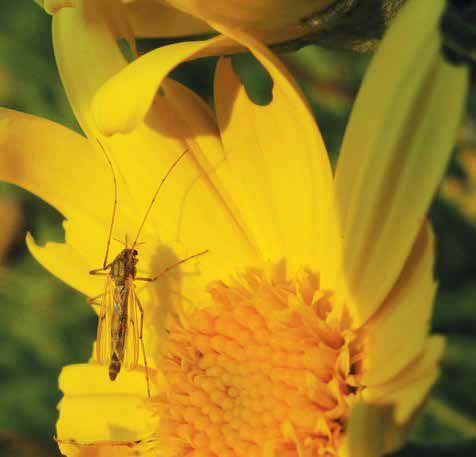
Chironomidae sp. midge female, the adult form of in the bloodworm life cycle. These insects are founding widely in North America, Europe and parts of Asia.
Awareness and pervasiveness of allergy
But how many aquarium enthusiasts are aware of this potential health hazard? AMAZONAS Magazine sought to get a clearer picture of bloodworm allergies in the aquarium hobby, and in May 2018 we conducted an informal online survey of aquarists, receiving 445 responses from the magazine’s readers.
Nearly 99 percent of respondents said they had fed bloodworms to their fishes, yet a full 40 percent were unaware of the allergy risk prior to our survey.
A large minority of respondents (47 percent) self-identified as being free from bloodworm allergy. However, 34 percent identified themselves as having a known or suspected allergy to bloodworms, and 19 percent said they were “unsure.”
Reporting that one in three aquarists may have a bloodworm allergy seems extremely high and raises the question of participation bias: were people who believe they have an allergy more likely to participate than those who don’t? Perhaps, although an earlier study (Bauer 1992) had remarkably similar findings—36.1 percent of people who had “hobby-related” exposure to bloodworms showed sensitivity to the associated allergens in bloodworms.
How do bloodworm allergies present?
Of the people reporting symptoms in response to bloodworm contact, 25 percent had a reaction the very first time. Of those who didn’t have an immediate reaction, 30 percent had an allergic reaction within a year’s time, and the median time to first reaction was four years.
Symptoms of a bloodworm allergy are readily identifiable (see table). Severity of reaction was rated on a scale of 1 to 10; very mild (tolerable, requiring no mediation) to most severe (potentially requiring a trip to the emergency room). Among individuals who initially responded that they were “unsure” if they had a bloodworm allergy, the average severity rating of symptoms was 2.9/10. Of the people who identified as having a known or suspected allergy, the average rating was 5.6/10.
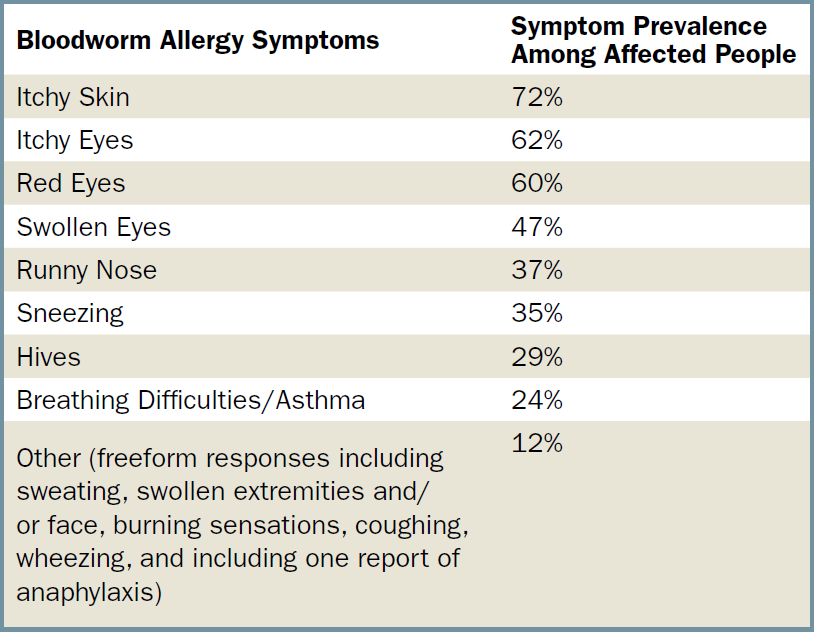
A rundown of symptoms reported by survey respondents who had known or suspected bloodworm allergies.
Acceptable risks?
A full 64 percent of the respondents who reported having known or suspected allergies said they were still coming into contact with bloodworms. When asked what they were doing to prevent or minimize bloodworm-associated problems, solutions included hand-washing (although often noted as ineffective) and minimizing contact by wearing gloves, using feeding tongs, feeding proportioned frozen worms (which require no direct handling), and wearing face masks. Others noted that only certain forms of the food caused reactions; multiple respondents said they avoid freeze-dried bloodworms but seem okay when working with frozen forms. But many, once they realized they were allergic, opted to avoid bloodworms entirely.
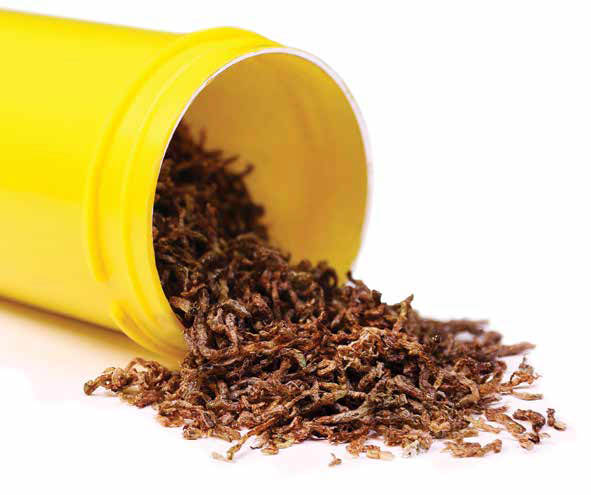
Dried bloodworms are anecdotally reported to cause more allergic reactions, but contact with frozen or live worms can also have effects on those with sensitivity to the hemoglobins in these insect larvae.
Continuing information
“With the increasing popularity of aquariums, allergy to chironomids may become less of a novelty and become something clinicians should be aware of when searching for the cause of a patient’s atopic symptoms,” concluded researchers Keith CP Wu and colleagues in 2005. In other words, if you feed bloodworms, keep this information in mind should you wind up going to the doctor with symptoms.
If you are experiencing symptoms, it’s best to get medical help or advice
To take our three- to twelve-question bloodworm allergy survey, see a more detailed breakdown of the data on which this report was based, get more information, and read the stories of other aquarists, please visit our online Bloodworm Survey Hub at http://www.reef2rainforest.com/bloodworm-allergy
Further Reading
Warning: Bloodworm Allergies Are Real for Some People
References
Fishing for Allergens: Bloodworm-Induced Asthma. https://www.ncbi.nlm.nih.gov/pmc/articles/PMC2877067/
Insect hemoglobins (Chi tI) of the diptera family Chironomidae are relevant environmental, occupational, and hobby-related allergens. https://www.ncbi.nlm.nih.gov/pubmed/1399031
Chironomidae hemoglobin allergy in Japanese, Swedish, and German populations. https://www.ncbi.nlm.nih.gov/pubmed/8198244

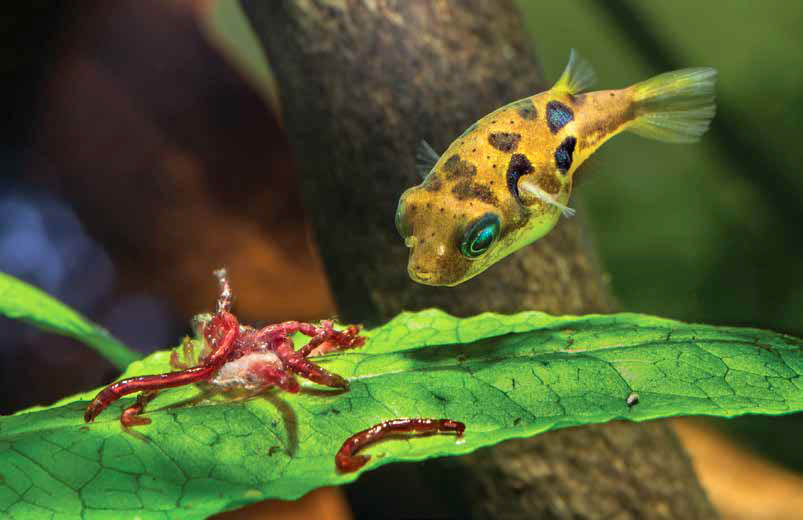





Hi Matt,
The Amazons heads-up was extremely timely for me. I had just recently been diagnosed with asthma and it coincided with being a year and a half into my new fish room with 5 tanks. Bloodworms were a staple 3-4 times a week. I’m now raising red wrigglers and my fish love them, but it is not all that easy to do. I have been looking for frozen mosquito larvae which supposedly are just as good or better than bloodworms and no one is allergic to them. No problem to get them in Europe – but big problem here. I found one place a 3 hour drive – 6 hour + round trip and I’m going to have to go clean him out, he doesn’t know where to reorder them. Anyone who can get the frozen mosquito larvae going here in the states can definitely make some bucks. With US Amazonas’ German parent company is there a chance they can get it going here?
Best,
Flick
I don’t think it is worth all that driving.
Fish are not pets such as dogs or cats.
For our family dog I would drive 3 hours.
Feed your fish something else.
There is so much good live foods out there.
I believe I have two of your prints hanging in my fish room.
If you are the artist, your art is great ,and wish I could afford your fish paintings.
Sorry about your health problems.
I doubt our community would allow the growing of mosquito larvae.
Well then dont you drive for 3 hours to purchase them, problem solved!
Your survey seems to me to be so unscientific.
How about a control group?
I am not an allergic person.
I have been feeding my fish frozren Blood Worms for over 10 years with no health problems.
I defrost and handle the frozen blocks purchased from JEHMCO without gloves.
Many of your responders may not have been checked for other health problems from other causes.
Jules, thanks for the great viewpoint. Did you take the survey? If not, please do.
To your question about a control group, we didn’t conduct a scientific experiment or study (which would have the appropriate experimental design, including a control group); e.g. we did not set out to determine whether there is or is not such a thing as a bloodworm allergy; that fact is already well established by other experiments, some of which I referenced here and in the other bloodworm article. We conducted a survey, which is simply the act of gathering input from a population; there is no “control group” in a survey. However, good survey design attempts to weed out people who are lying. Just as an example – someone who’s never fed bloodworms yet reports that they have an allergy, there’s potentially something wrong with that response. The survey responses had almost nothing in the way of responses that needed to be thrown out, and when I looked, throwing out the questionable responses didn’t significantly change the numbers.
You are absolutely correct – there are no doubt respondents who may have responded that they “do” have a bloodworm allergy but in fact do not. By the same token, however, there could also be those that don’t realize that they have a bloodworm allergy, but they do. We didn’t actually ask every survey respondent to go take an allergy test of course. But I find it very compelling that, comparing the data collected through our survey, with the data collected by researchers doing tests specifically for antigen sensitivity, the numbers are remarkably similar. That, to me, does suggest a certain level of validity to the responses provided by the survey participants. Of course, it could be completely coincidental too.
I know this article is 5 years old, but I have a hypersensitivity to bloodworms.
I have used them for decades with no problems.
A few summers ago, for some unknown stroke of terrible luck, I was stung by 3 wasps in a 6 week period of time.
First sting, no issue. Second sting was the following week, I had a moderate localized swelling reaction. Third sting was a few weeks later and I had a very fast and very sever swelling reaction.
Within a week of the last wasp sting, I began to notice allergic reaction to freezedried bloodworms. Swollen itchy eyes, hives on my neck. I stopped using them, the problem went away.
About a year ago, I got pea puffers and started using frozen bloodworms. I try very hard to minimize contact, but occassionally I rub an eye and it causes a very fast, very drastic reaction, worse than the freeze dried were causing.
Recently in the past several months, I have been getting asthma attacks. They aren’t too horrible or frequent, so I just wrote it off until I started thinking they may be related to bloodworms.
So today, armed with a box of primatine tablets, I smashed up a block of frozen bloodworms, trying to minimize exposure. I kept the worms in a freezer bag, used utensils, cleaned my hands.
Regarless, within several minutes, I felt the itching in my throat and within 90 minutes, I was taking primatine for an asthma attack.
There seems to be a link between the hornets and wasps, and bloodworms, and my allergic reactions are escalating.
I’ll stop using them as soon as this darn blackworms shortage ends.
I just have a hard time accepting that only 47% of us hobbyists are completely immune to any symptoms. I’ve only ever heard of one case of an extreme medical emergency from my area. No one else has said that they were having any reactions/symptoms. I have to agree with jules a birnbaum about other health issues may be at issue here too.
I don’t think the survey asked all the right questions for a complete analysis of this issue, but I understand how Amazonas doesn’t want to get too involved in peoples lives for medical reasons. After all, who wants to put out their medical history on the web!
Clearly this is an open door for further research…
Indeed Joe!
Joe. I know this os 5 years later since u wrote this. I had to write you and tell u what happen to my daughter who just got 2 fighter fish and bought the worm. Anyways
3 nights ago she was fine
Woke up 8am, went pee, had nothing wrong with her. She Started screaming so loud “help! It burn! Welts co ered her body,911was called. Dr’s had no idea why she came so close to dying.
For me the blood worm allergy is real. Just the smell of the worms gives me asthma. I’m not going to feed them again. Not worth the health risk especially with so many other food alternatives.
I am not a person prone to allergies, but I am allergic to bloodworms. I have sort of brushed off the mild reactions to bloodworms to start with, but the reactions have become more severe so either I won’t be the one handling them anymore, or I will transition to blackworm. I initially had sneezing ( repeatedly), watery eyes, runny nose, coughing, and itchy throat (intense) even to the skin on my thoat area externally. Now, it’s the same symptoms, but now I get welps, or white itchy mosquito bite like patches where the blood worms have had contact. I started being careful, holding my breath while feeding them, but then I developed skin reactions. I held some under the water to soak, and now I have welps where some floated up and touched my arm, and I always wash after. It also makes my throat feel like it’s swelling a bit.